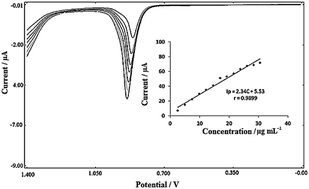Determination of diethofencarb (isopropyl 3,4-diethoxyphenylcarbamate) by square wave voltammetry using a multiwall carbon nanotube paste electrode
Abstract
The fungicide diethofencarb has been studied by square wave voltammetry (SWV) using a multi wall carbon nanotube paste electrode (MWCNTPE). The peak potentials have been shifted in a more negative direction with increasing pH, showing a maximum peak response at +861 mV (vs. Ag/AgCl) and pH 2.0. Operational parameters affecting the sensitivity and selectivity such as accumulation potential (Eacc), accumulation time (tacc), frequency (f) and pulse amplitude have been optimized. The constructed calibration curve was linear within a concentration range of 2.50 μg mL−1 to 30.5 μg mL−1. The calculated limit of detection (LOD) and limit of quantification (LOQ) values were 0.77 μg mL−1 and 2.57 μg mL−1, respectively. The determination was realized in the presence of various fungicides to demonstrate the selectivity, accuracy and applicability of the recommended method. Spiked tomato juice samples with 2.50–7.50 μg mL−1 diethofencarb were subjected to the proposed method and recoveries of over 97% and relative standard deviations of less than 3.8% reflected a high degree of accuracy and precision.


 Please wait while we load your content...
Please wait while we load your content...